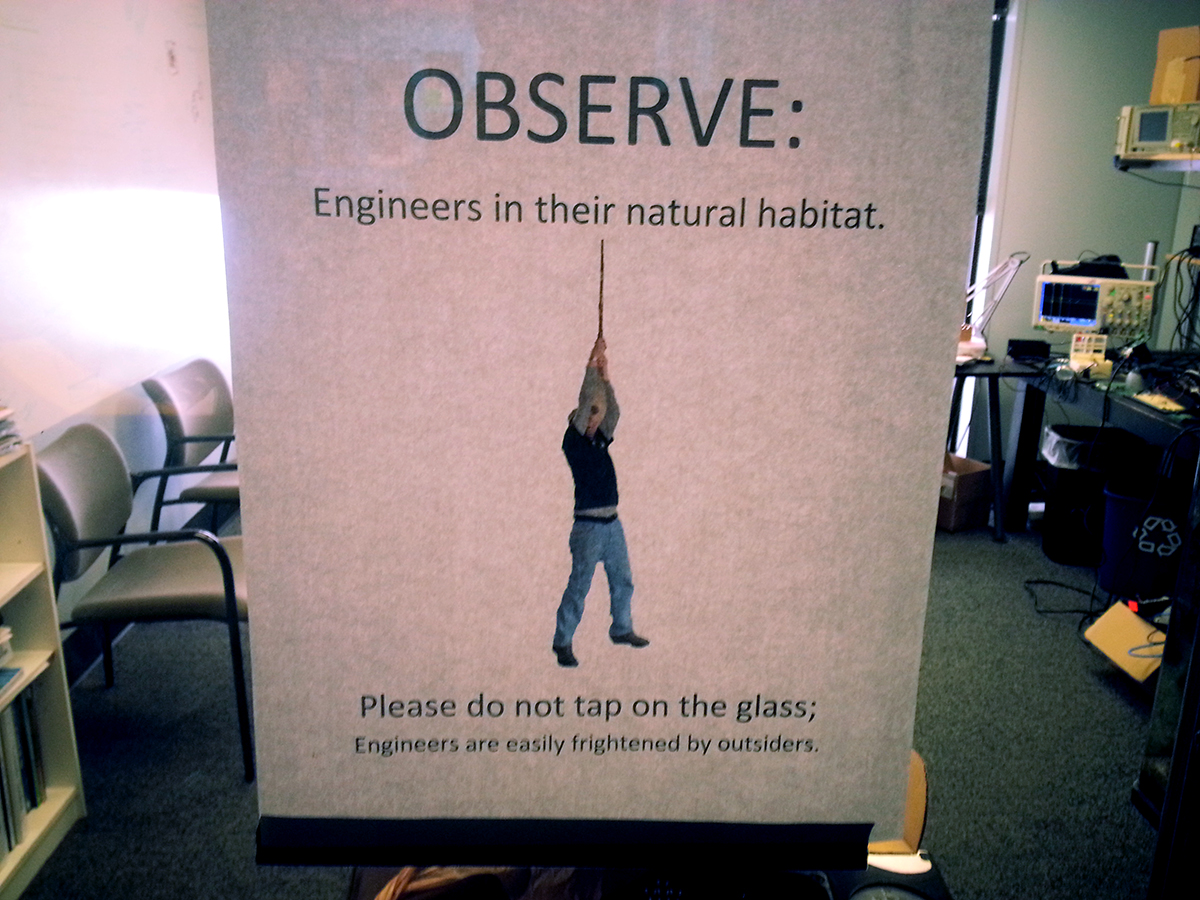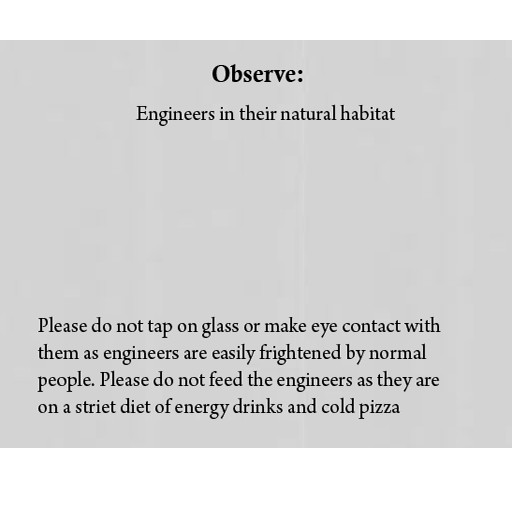
Erdem Yigit Ertorer on Twitter "physicists & software engineers in
Allogenic engineers physically change biotic and abiotic materials in their habitats. Autogenic engineers alter their environments by making changes to their own structures. Beavers are an example of an allogenic engineer because when they build a dam, they modify their environment.

Engineers in their natural habitat. YouTube
Animals can play important roles in structuring the plant communities in which they live. Some species are particularly influential in that they modify the physical environment by changing, maintaining, and/or creating new habitats; the term ecosystem engineer has been used to describe such species. We here assess the two major foraging strategies of primates, frugivory and folivory, in terms.

Engineers in their natural habitat. Seen in NY programmerhumour
The concept holds that ecosystem engineers alter habitats through two overarching mechanisms. Autogenic engineers transform ecosystems by their own growth and are integral to the altered environment. Corals, for example, build reefs for their own needs that also serve countless other species. Although some species feed on coral, most, including.

Natural Habitat » Josh Mitchell Photography
Nature's Engineers admin , 11 November 2018 Beaver © David Plummer By Fran Southgate Living Landscape Advisor How wildlife shapes our landscapes Planet earth is a fascinating and ever-changing place. Day by day it is shaped as much by what lives on its surface, as it is by other natural processes like wind, waves and fire.

Types in their natural habitat 1 INTJ (redo) r/mbti
3. Ecosystem Engineers and Habitat Modification 3.1 Altered landscapes and soil structures. The activities of ecosystem engineers can result in significant modifications to landscapes and soil structures. For instance, elephants play a key role in shaping their environment by uprooting trees, creating open spaces, and promoting the growth of.

Engineers in their natural habitat 9GAG
An ecosystem engineer is an organism whose presence or activity alters its physical surroundings or changes the flow of resources, thereby creating or modifying habitats and influencing all associated species ( Jones et al. 1994, 1997 ). For example, a beaver creates ponds and wetlands where there were previously running streams.

Engineers in their natural habitat [Team Fortress 2] [Sprays]
Engineers in their natural habitat Archived post. New comments cannot be posted and votes cannot be cast. 484 32 Share Sort by: Open comment sort options ObnoxiousCritic • 7 yr. ago Sitting barefeet on the table, MacBook. These are not engineers, they're designers. Evil-Toaster • 7 yr. ago

ObserveEngineers in their natural habitat.Please do not tap on glass
Jones and colleagues (1997) hypothesized that at a scale encompassing unmodified or "virgin" habitats, engineered habitats, and degraded areas abandoned by engineers, the net effect of ecosystem engineering should be to enhance species richness via a net increase in habitat diversity. Recent studies provide support for this hypothesis.

Engineers in their natural habitat [Team Fortress 2] [Sprays]
How about this for a place to work? With the Eastern part of the Saitama province in Japan prone to flooding, the Land, Infrastructure and Transport Ministry began a 240 billion Yen programme to build one of the world's most impressive storm drains.

types in their natural habitat 1 intj mbti
Ecosystem engineers (also termed habitat modifiers or bioconstructors) are defined as organisms that affect other biota via alterations to the abiotic environment [1, 2] either directly with their bodies (e.g., add structure) or their activities (e.g., dig a hole) or indirectly through their biotic interactions (e.g., eat the canopy and let more light in the forest).

And now we can observe a colony of wild engineers in their natural
Graphical Abstract. This article reviews the state-of-the-art scientific understanding of the beaver as an ecosystem engineer. It summarizes how beaver impact: (a) ecosystem structure and geomorphology, (b) hydrology and water resources, (c) water quality, (d) freshwater ecology, and (e) humans and society.

Types in their natural habitat 9 ESTJ mbti
Eager beavers: How nature's engineers can help save the planet 23 May 2019 Environmental journalist Ben Goldfarb's epiphany arrived at a conference of evangelical Beaver Believers in 2015. The.

My trip to EcoTech Marine AquaNerd
An ecosystem engineer is an organism that significantly influences its environment by creating, modifying, or maintaining habitats, thereby shaping the structure and function of ecosystems. These organisms play a crucial role in ecosystem dynamics and support the overall biodiversity and resilience of the natural world.

Engineers in their natural habitat [Team Fortress 2] [Sprays]
Ecosystem engineers are species that create, destroy, modify, or maintain habitats in significant ways. These uniquely productive animals create conditions for other species to benefit from,.

Engineers in their natural habitat [Team Fortress 2] [Sprays]
The 'hidden' life of an ecosystem engineer. For his senior thesis, Joe Kawalec of the Class of 2021, who graduated Princeton with a bachelor's degree in ecology and evolutionary biology with a certificate in environmental studies, studied the natural camouflage of downy woodpeckers to understand how it helps the small bird survive in its.

DVIDS News Green tech Corps of Engineers wetland habitat lowers
This paper presents the most recent definition of ecological engineering, examines the new field in its historical context, contrasts it with other fields, presents a classification system for ecological engineering projects, and summarizes recent events related to the development of the field. Page 112